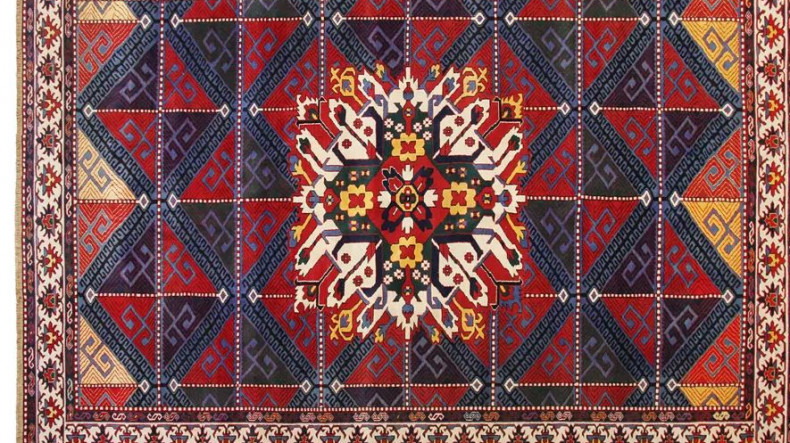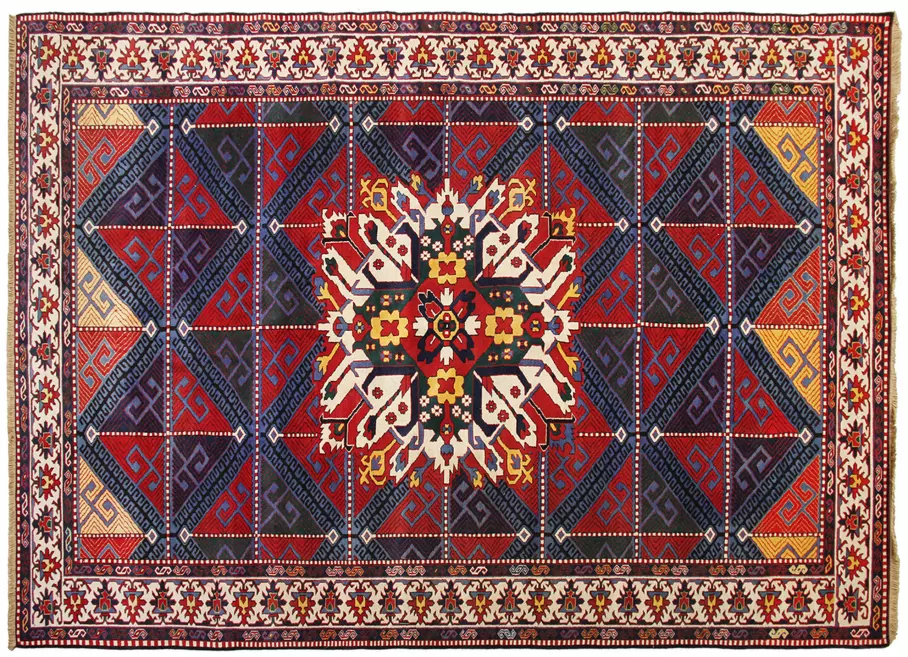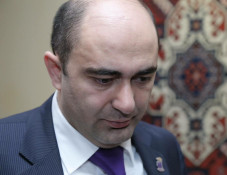
Replicas of Artsakh carpets presented in Latvia as symbols of Azerbaijan’s 'genetic code'
The Artsakh Monument Watch reports that replicas of Artsakh’s Armenian carpets featuring unique ornaments are being presented in Latvia as symbols of Azerbaijan’s “genetic code” and historical memory. Read its full statement below.
"Recently, Azerbaijan has intensified its policy of appropriating Armenian heritage on various international platforms through exhibitions, lectures, and academic conferences. This effort is particularly focused in the Baltic region, notably in Latvia, where Artsakh carpets adorned with unique Armenian ornaments and designs are presented as part of Azerbaijan's traditional carpet-making culture, branded as "Azerbaijani carpets." The centerpiece of this campaign is the exhibition titled "The Genetic Code of Memory," prominently featuring Armenian rugs from Nagorno-Karabakh and regions of Armenia. These carpets incorporate distinctive signs, animal and bird motifs, decorative compositions, and associated beliefs integral to Armenian carpet-making culture, with a history spanning centuries.
The exhibition, organized in cooperation with the Embassy of the Republic of Azerbaijan in Latvia and Azerbaijan's "Azerkhalcha" carpet weaving company, commemorates the 30th anniversary of diplomatic relations between Azerbaijan and Latvia, underscoring the official nature of the event. Attendees included government and parliamentary officials of Latvia, heads of diplomatic missions, representatives from local cultural, social, and media organizations, as well as members of the Azerbaijani community residing in Latvia.
The carpets of the "Azerkhalcha" company showcased at the Azerbaijani carpet exhibition in Riga, Latvia, include samples that replicate designs such as the "Artsvagorg" from the carpet-making center of Jraberd (Dzhraberd, Jraberd) in Artsakh, the "Vorotan" type carpet from the Goghtn province of Syunik and Nakhichevan, as well as Shirvan carpets. Jraberd, noted as a fortress in Greater Armenian Artsakh, was a prominent carpet-making center during the 16th-17th centuries, where the "Jraberd" type "Artsvagorg" originated (Hakobyan T., Barsegyan H., Dictionary of Toponymy of Armenia and Adjacent Territories, vol. 4, Yerevan, 1998, p.417).
The primary decorative motif of the "Artsvagorg" carpets is the Eagle (Fig. 1, 2). This motif symbolizes the winged Sun or the Urartian deity Khaldi, also associated with Zoroastrian Ahura Mazda. The iconography of the winged sun has been present in Armenian art since ancient times and continues into the late medieval period, particularly in Armenian carpets from Artsakh-Syunik. In foreign literature, it is referred to as "Tschelaberd" (See Adil Besim, Mythos und Mystik, Alte und antike Textilkunst, Vienna, 1998, p. 22). At the exhibition, these carpets were presented under the names Chalabi or Chelebi.
The carpet featuring motifs of horsemen, deer, and predatory animals at the Latvian exhibition (Fig. 3) bears resemblance to similar carpets from Shirvan and Dagestan, drawing comparative parallels with carpets produced by the Qashgai nomadic tribe of Iran (Jourdan Uwe, Persische Teppiche, Augsburg, 1995, pp. 188-189).
This exhibition, running until September 15, serves not only as a display of appropriated Armenian art but also carries a profound political subtext. Its long-term objective appears to be rewriting history, erasing the Armenian identity and heritage from the Nagorno-Karabakh region, and cementing these changes internationally. The exhibition raises significant concerns regarding the preservation of cultural heritage and poses ethical questions about the implications of such displays.
At the opening ceremony of the exhibition, Elnur Sultanov, Ambassador of Azerbaijan to Latvia, highlighted the historical significance of the 30th anniversary of diplomatic relations between Azerbaijan and Latvia. He asserted that carpets featuring typical Artsakh ornaments are part of the heritage of the Azerbaijani people, noting that Azerbaijani carpet weaving was inscribed on the UNESCO World Heritage List in 2010 under the representative list of material cultural heritage. This is the same list that includes "The art of Armenian khachkars: symbolism and craftsmanship," while Azerbaijan has been involved in the systematic destruction of Armenian artifacts, including many historical and modern khachkars in Artsakh.
Returning to the exhibition, it's important to note that its main exhibits are products from Azerkhalcha (Azerxalça), the sole carpet producer in Azerbaijan. This underscores that the creation of collections featuring replicas of Artsakh ornaments by this factory is monopolistic and state-sponsored.
What is even more concerning is that the exhibition includes educational programs that aim to erase Armenian cultural presence. This is evidenced by the scientific hearings and lectures held on May 29 at the same museum, where Ms. Vija Buša, the current Deputy Head of Mission at the Embassy of Latvia in Azerbaijan, delivered a lecture. In her presentation, Ms. Buša portrayed Shushi as a centuries-old cultural capital of Azerbaijan. The lecture also highlighted research on the work of Latvian artist and ethnographer Yulia Straume. It's important to note that Ms. Buša's involvement extends beyond diplomatic consultation in organizing the exhibition. She also supports initiatives promoting the global Islamization of Shushi and presents it as Azerbaijani territory.
It should be noted that Azerbaijan pursues a state-directed policy aimed at manipulating the historical and cultural image of Shushi. On one hand, this involves organizing various Islamic conferences in Shushi to present the city internationally as exclusively Azerbaijani and Turkic, seeking international recognition and legitimacy for this narrative. On the other hand, Azerbaijan's actions include the destruction of existing Armenian cultural heritage and monuments in Shushi. These trends are evident in all programs and speeches where Shushi is portrayed solely as an Azerbaijani and Turkic settlement, omitting any mention of its rich Armenian cultural heritage, historical significance, and the presence of numerous Armenian monuments. For instance, Azerbaijan submitted documents to UNESCO in 2021 to designate Shushi as an Azerbaijani city within the "UNESCO Creative Cities Network". Furthermore, Baku declared Shushi as the "Cultural Capital of the Turkic World" in 2023.
Our response
The people of Artsakh, who have a rich tradition of carpet weaving, are currently deprived of the ability to continue this cultural practice due to forced displacement. This situation not only prevents them from contributing to the cultural life of their community but also constitutes a severe violation of their right to culture, as outlined in Article 27 of the Universal Declaration of Human Rights and Article 15 of the International Covenant on Economic, Social, and Cultural Rights, which address cultural rights. On one hand, Azerbaijan halted the practice of carpet weaving among Artsakh Armenians through forced deportations. On the other hand, this action has deprived them of the opportunity to enrich and safeguard their intangible cultural heritage.
The exhibition of carpets in Latvia represents a covert yet perilous appropriation of Armenian cultural heritage. By distorting historical facts, Azerbaijan undermines the genuine tradition of this heritage, stripping it of its authenticity. This action violates the principle of authenticity of heritage recognized by UNESCO. According to the document adopted in Nara in 1994, heritage must embody true and reliable knowledge, grounded in accurate information that is responsibly maintained. The misrepresentation of Armenian cultural artifacts in the exhibition not only misleads but also erases the rightful historical narrative, perpetuating a disservice to cultural integrity and historical truth."

Fig. 1 A copy of the main fabric of the Armenian "Jraberd" type "Artsvagorg" presented at the Azerbaijani exhibition in Latvia.
.jpg)
Fig. 2 A copy of the main pattern of the carpet belonging to the Armenian "Jraberd" type, presented at the Azerbaijani exhibition in Latvia.
.jpg)
Fig. 3 A carpet depicting horsemen, deer, and predatory animals, originating from Shirvan.
Newsfeed
Videos






























